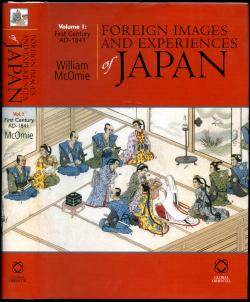Foreign Images and Experiences of Japan: Volume I: First Century AD-1841

Compiled, edited and in part translated by William McOmie
Global Oriental, Folkestone (2005)
ISBN 1-901903-46-X
Review by Sir Hugh Cortazzi
This is the first comprehensive survey covering the observations and reports of foreigner visitors about Japan. It will be a very useful reference book for students and researchers interested in the reactions of foreigners to Japan over some 1800 years. Professor McOmie has trawled widely and with scholarly care through all the sources. His study of Russian, German and Dutch sources has yielded much unfamiliar material.
The book is divided into two parts. In the first 97 pages he surveys chronologically the various foreign visitors to Japan who have left records of their impressions. McOmie is particularly interesting on the Russian visitors to Japan and notes (page xv) that "Russian records strongly suggest that they were more successful in forming a genuine friendship with the Japanese, if only on an individual basis." He pays due attention to the most famous commentaries such as those of Frois, Caron, Kaempfer, Thunberg, Golovnin and von Siebold, but also quotes extensively from less well known sources.
The second part deals thematically with the observations of foreign visitors and includes copious quotations. These enable readers to follow the changes in attitudes as the centuries passed and to compare for instance what struck a Jesuit in the sixteenth century with the observations of 18th century visitors.
Although foreign observers were often critical of aspects of Japan they were frequently impressed by "the great refinement" of Japanese social graces. Valignano, the Jesuit visitor in the sixteenth century, stressed Japanese punctiliousness about their honour. Thunberg, the Swedish doctor with the Dutch on Dejima in the eighteenth century summed up his view of the Japanese, in a long string of adjectives, as being "in general intelligent and provident, free and unconstrained, obedient and courteous, curious and inquisitive, industrious and ingenious, frugal and sober, cleanly, good-natured and friendly, upright and just, trusty and honest, mistrustful, superstitious, proud, and haughty, unforgiving, brave and invincible." Japanese cleanliness drew praise from many, but Japanese traits which aroused many critical comments were their promiscuity and their cruelty. McOmie quotes (page 254) a Dutch source of 1833 Overmeer Fisscher who found temples "given over to drunkenness and debauchery." Kaempfer (page 248) was shocked to see "well-dressed and painted boys…who could be had by rich clients travelling past for a repugnant, damned sum of money." Frois and Kaempfer both mentioned the outcasts from Japanese society the eta and the hinin.
Some of the most interesting descriptions quoted by McOmie are those of the cities which the foreigners visited. Nagasaki was "one of the most attractive cities" (page 365) with the natural beauty of its bay, but the Dutch settlement on the artificial island of Deshima was seen for what it was "a prison" even if a rather comfortable one. Siebold was "put off by the outmoded dress and mannerisms of the Dutch penned up in the island (page 371)." Osaka and Kyoto impressed many of the visitors. Edo (now Tokyo) was seen from the beginning of the seventeenth century as the great city it had become. Velasco (1609-10), the Spanish governor from Manila. considered (page 378) the streets of the city as "far broader, longer and straighter than the streets of Spain. They are kept so clean that you might well think that nobody ever walks along them."
McOmie devotes a chapter to the "theme of the 'oppositeness' of Japanese culture vis á vis Western culture." Frois, the sixteenth century Jesuit, (page 387) "reported a much greater frequency and acceptability of killing human beings in Japan than in Europe, but a great reluctance to kill animals." Foreign doctors such as Thunberg gave a very negative assessment of Japanese medical knowledge.
The final chapter on "Audiences and Inspections" contains some interesting accounts. The Jesuit Frois found the dictator Oda Nobunaga cordial and welcoming, but later Dutch envoys who were granted audiences with the Tokugawa shoguns found the process pretty excruciating. Siebold (page 463) complained about the empty ritual of calling on absent lords: "Nowhere did we find the masters at home."
It would be interesting to know how far the observations of these foreign visitors reflect the real position as seen by Japanese historians and how much value the foreign accounts are to historians who are studying Japanese social history. But it would have been a huge and difficult task to do the necessary research in Japanese histories. We should be grateful for what we have been given: this is a valuable and fascinating compendium.

